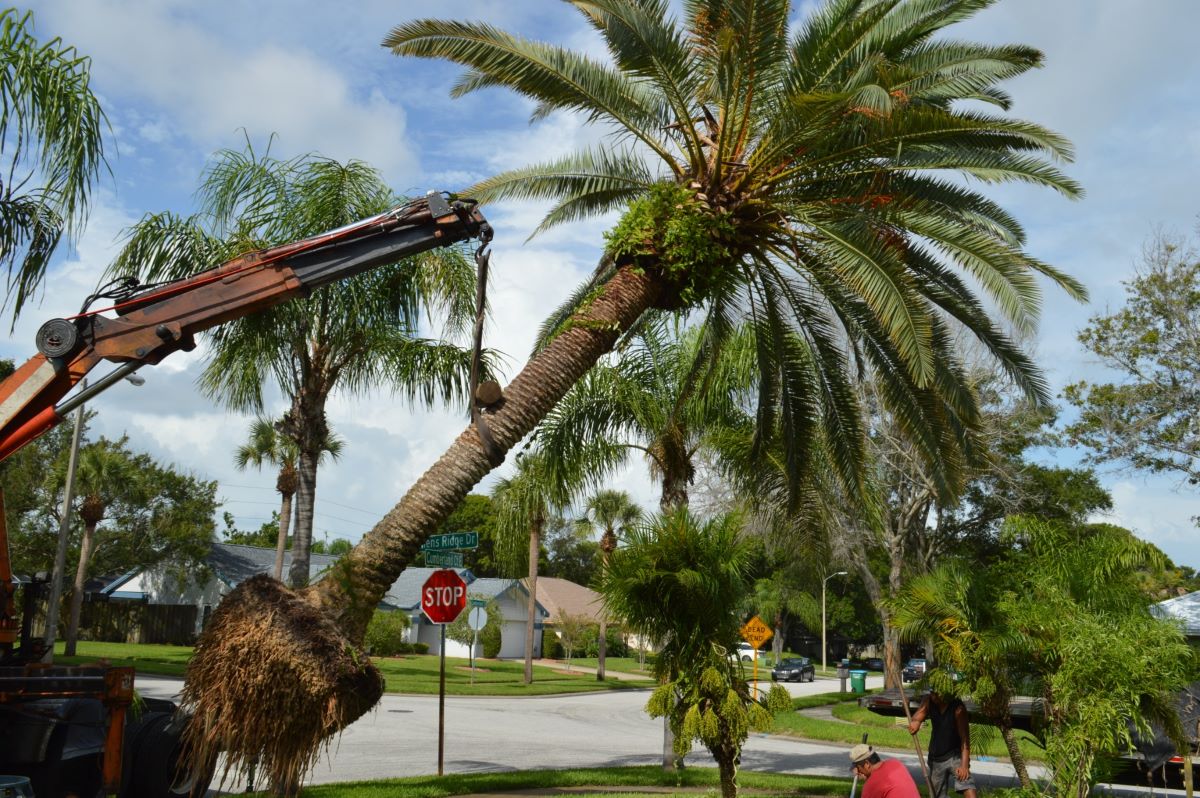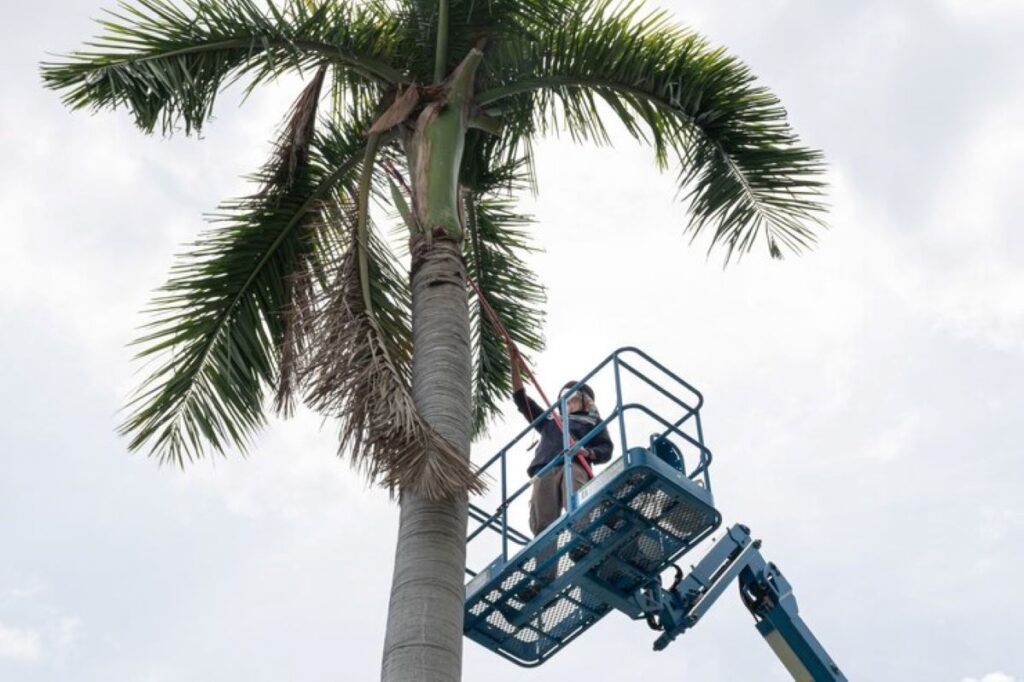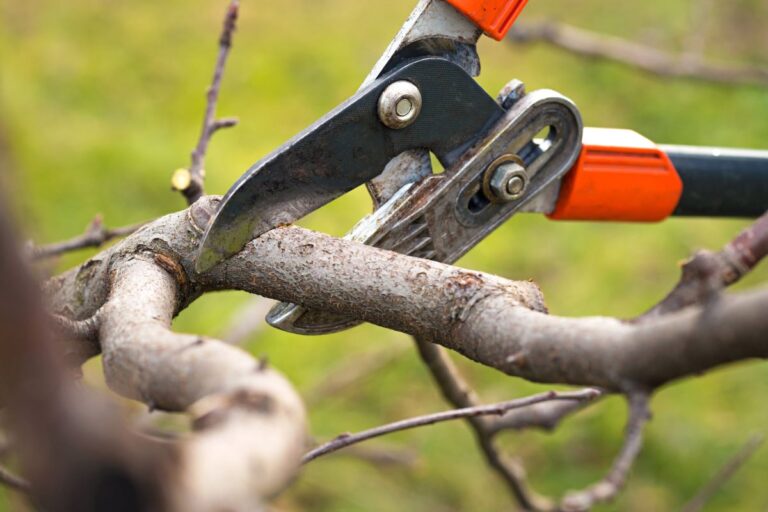Palm tree pruning is an important part of taking care of these magnificent tropical plants. This necessary maintenance task involves carefully removing dead, damaged, or unwanted fronds, flower stalks, and fruit clusters to improve the health and appearance of palm trees.
Regular palm pruning offers several benefits:
- Improved Appearance: Proper pruning gives a neat and well-kept look that enhances any landscape
- Disease Prevention: Getting rid of dead or dying fronds reduces potential breeding grounds for harmful pests and diseases
- Safety Assurance: Removing loose or hanging fronds minimises risks to people and property
- Growth Stimulation: Strategic pruning encourages healthy new growth and proper nutrient distribution
- Structural Strength: Removing excess weight from the crown helps prevent trunk damage during storms
The effects of professional palm tree pruning go beyond just the trees. A well-maintained palm improves the look of a property, increases its value, and creates a safer environment for residents and visitors. This practice also allows better airflow and sunlight to reach surrounding plants and vegetation.
To ensure these valuable landscape assets stay healthy and beautiful for years to come, it’s important to use proper pruning techniques that require expertise and specialised knowledge. Knowing the right methods, timing, and tools for palm tree pruning is essential in avoiding any harm to these botanical treasures.
Understanding the Importance of Palm Tree Pruning
Regular palm tree pruning is crucial for protecting the tree from various threats that can harm its health. Removing dead or dying fronds is essential for preventing pests, as these fronds provide a perfect breeding ground for harmful insects and fungal diseases.
Key Disease Prevention Benefits:
- Reduces susceptibility to fungal infections
- Eliminates hiding spots for harmful insects
- Prevents the spread of existing diseases
- Minimises moisture retention that attracts pests
The removal of dead fronds is also important for promoting healthy growth in palm trees. These fronds drain nutrients from the tree, diverting resources away from new growth. By pruning strategically, we can redirect these nutrients towards:
- Developing new fronds
- Strengthening the root system
- Producing flowers and fruits
- Maintaining overall structural integrity
Signs That Signal Pruning Necessity:
- Yellowing or browning fronds
- Hanging or drooping palm leaves
- Visible pest infestations
- Dense canopy blocking light penetration
Professional arborists understand that different species of palms and varying climate conditions require specific pruning techniques. This tailored approach helps preserve the tree’s natural defence mechanisms while encouraging healthy growth patterns. Additionally, removing dead fronds reduces the risk of falling debris during storms or strong winds, ensuring safety in surrounding areas.
Effective pruning methods create an environment where beneficial insects can thrive while deterring harmful pests. This natural equilibrium promotes long-term health for palm trees and decreases reliance on chemical treatments. By consistently maintaining through thoughtful pruning practices, we establish a solid foundation for both urban and natural landscapes to support thriving palm trees.
Mastering Best Practices for Palm Tree Pruning
Successful palm tree pruning requires precise techniques and strategic timing to maintain tree health and appearance. Here’s a detailed guide to master the art of palm pruning:
Step-by-Step Pruning Guide
1. Identify Target Fronds
- Dead or yellowing fronds
- Damaged or broken leaves
- Flower stalks and fruit stems
2. Position the Cut
- Place cuts 5-8 cm from the trunk
- Maintain a clean 45-degree angle
- Avoid cutting into the trunk tissue
3. Execute Clean Cuts
- Use sharp, sanitised tools
- Make swift, decisive cuts
- Remove entire fronds in one motion
Optimal Pruning Schedule
Spring Pruning
- Remove winter-damaged fronds
- Clear dead flower stalks
- Prepare for new growth season
Late Summer Pruning
- Trim yellowing lower fronds
- Remove spent flower stems
- Shape crown for storm season
Critical Timing Considerations
When planning your palm tree pruning, it’s essential to consider Florida’s seasonal tree care tips. Here are some general guidelines:
- Avoid pruning during cold snaps
- Schedule work for dry weather conditions
- Limit pruning to 2-3 times annually
- Space sessions 4-6 months apart
Professional Tip: Leave a minimum of 2 rows of live fronds below the growing tip to protect the palm’s health and structural integrity. The natural crown shape resembling a half-sphere provides optimal protection and nutrient distribution for the palm.

Essential Tools and Safety Measures for Effective Palm Tree Pruning
Professional palm tree pruning requires specific tools and safety protocols to ensure both the health of the trees and the safety of those performing the maintenance.
Essential Pruning Tools:
- Hand pruning saws with curved blades
- Pole saws for reaching higher fronds
- Sharp, clean pruning shears
- Heavy-duty loppers for thick fronds
- Protective gloves with grip enhancement
- Safety goggles and hard hats
- Sturdy extension ladders or cherry pickers
Tool Selection Tips:
- Choose tools with rust-resistant materials
- Ensure handles provide secure grip
- Select appropriate blade sizes for frond thickness
- Invest in professional-grade equipment for durability
Sanitisation Protocol:
- Remove debris from tools after each use
- Wash tools with soap and water
- Disinfect blades with:
- 70% isopropyl alcohol solution
- 10% bleach solution
- Commercial disinfectant approved for garden tools
- Allow tools to dry completely before storage
Safety Considerations:
- Inspect tools before each use
- Replace damaged or worn equipment immediately
- Store tools in dry, secure locations
- Keep blades sharp for clean cuts
- Maintain proper tool maintenance records
The spread of diseases between palm trees often occurs through contaminated pruning tools. A strict sanitisation routine between trees prevents cross-contamination and protects the entire palm collection from potential infections. Professional arborists recommend dedicating specific tools to diseased trees to minimise risk of spreading pathogens to healthy specimens.
For those who prefer a hands-on approach, DIY tree care can be an effective alternative, provided that the necessary precautions are taken and proper techniques are followed. You may like to visit https://adc-icty.org/tree-pruning-services-sydney-benefits-for-your-trees/ to check out more about tree pruning services sydney: benefits for your trees.
Routine Maintenance Practices to Keep Your Palms Thriving
Regular maintenance practices create the foundation for healthy, thriving palm trees. A structured approach to palm care ensures these majestic plants maintain their beauty and vitality throughout the seasons.
Essential Maintenance Schedule:
- Remove dead or yellowing fronds every 3-4 months
- Trim flower stalks and fruit clusters bi-annually
- Clear accumulated debris from the crown quarterly
- Inspect for signs of pest infestation monthly
- Check trunk stability during routine maintenance
Proper disposal of pruned materials plays a crucial role in preventing disease spread and maintaining garden hygiene. The recommended disposal methods depend on the condition of the pruned materials:
Healthy Palm Materials:
- Create mulch from dried fronds. Mulching is beneficial as it retains soil moisture and suppresses weeds.
- Add to compost bins in small quantities
- Use as garden bed covering
- Break down for green waste collection
Diseased Palm Materials:
- Seal in heavy-duty bags
- Label as contaminated waste
- Avoid mixing with general garden waste
- Contact local waste management for specific disposal guidelines
Professional arborists recommend maintaining detailed records of pruning activities, including dates, specific tasks performed, and observations about the palm’s health. This documentation helps track the palm’s response to maintenance practices and aids in identifying potential issues before they become severe.
A consistent maintenance schedule paired with proper disposal practices creates optimal conditions for palm trees to flourish. These routine care practices complement other essential aspects of palm tree health management, such as integrated pest management strategies which are crucial in safeguarding your palms against pests and diseases. Additionally, understanding how to protect your organic garden from pests and diseases during winter can also be beneficial for maintaining overall garden health.
Additional Tips for Ensuring Optimal Palm Health Beyond Pruning
Proper palm tree care extends beyond pruning practices. A comprehensive approach to palm maintenance includes several crucial elements:
Species Selection
- Choose palm varieties suited to local climate conditions
- Research mature size requirements for available space
- Consider growth rate and maintenance demands
- Select disease-resistant varieties when possible
Watering Practices
- Deep watering encourages robust root development
- Maintain consistent soil moisture without waterlogging
- Adjust watering frequency based on seasonal changes
- Install proper drainage systems to prevent root rot

Fertilisation Schedule
- Apply slow-release fertilisers designed for palms
- Include essential nutrients: nitrogen, phosphorus, potassium
- Address specific nutrient deficiencies through targeted supplements
- Time applications during active growth periods
Environmental Protection
- Shield young palms from harsh winds
- Provide adequate sunlight based on species requirements
- Maintain proper soil pH levels
- Create buffer zones to protect from lawn equipment damage
Professional arborist services can develop customised care plans addressing these aspects, ensuring palm trees receive optimal care throughout their lifecycle. Regular monitoring and adjustments to care routines help maintain healthy, thriving palms that enhance property aesthetics and value.

